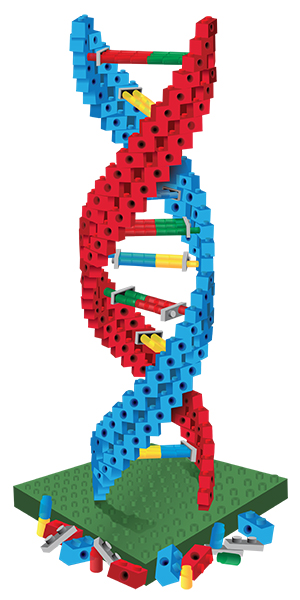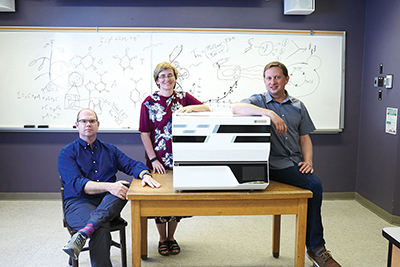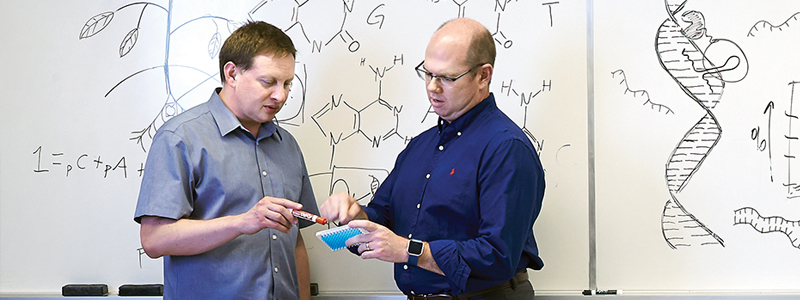Redesigning Life As We Know It
Synthetic biology has opened up a limitless world of opportunity for scientists, making it possible to create products like pharmaceuticals and non-browning food from scratch. But not everyone has welcomed this futuristic scientific advancement with open arms.
By Jesica Hurst, BA’14
Think back to being a child, when the sole purpose of using your imagination was for exploration, adventure and fun.
As a child it is not only welcomed, but ultimately encouraged, to be creative and think outside of the box. We are taught to write fictional stories and paint pictures and build structures from Lego blocks that once were just imagined in the mind.
 The interesting thing is, if you give five different children the same set of Lego blocks to build from, you will almost certainly get five different creations. The ingredients may be exactly the same, but the outcomes will be entirely different. The only thing separating each child’s design is the imagination that they came from.
The interesting thing is, if you give five different children the same set of Lego blocks to build from, you will almost certainly get five different creations. The ingredients may be exactly the same, but the outcomes will be entirely different. The only thing separating each child’s design is the imagination that they came from.
The field of synthetic biology works in a similar way. Throughout the past decade, advancements in technology and research have led scientists to a place where they have the ability to design and construct new biological parts, devices and systems, and re-design existing natural biological systems.
Considered by many as the ‘new frontier’ of science, synthetic biology has opened up a limitless world of opportunity for scientists. And similar to children and their Lego creations, the end results and applications of scientists’ work are limited only by their imagination of what they can do.
“The term synthetic biology is a new creation, and there were a lot of things that made the field of synthetic biology possible,” said David Edgell, PhD, an Associate Professor in Biochemistry. “It’s an intersection of many fields – an enterprise that enables people to use all of these technologies to do many different things.”
Edgell added that synthetic biology also means many different things to many different people. “In my mind I understand it and think about it in a certain way, but if you were to ask other synthetic biologists they may have a different answer,” he said.
While the opportunities that surround the field of synthetic biology are broad and will continue to expand in the future, there are currently a few applications that have not only gained traction but also made a direct impact on humanity.
One popular example is Stanford researcher Jay Keasling’s use of synthetic biology to create synthetic biological pathways for the synthesis of an antimalarial drug called Artemisinin. Prior to synthetic biology, the drug was harvestable only from certain plants, and it was incredibly time consuming and expensive. Keasling used the principles of synthetic biology to genetically engineer yeast to recreate the drug, which is now used in developing countries.
Synthetic biology also made the Arctic apple – the famous non-browning fruit – possible, and it is currently being sold in produce aisles in North America.
While it may seem like these advancements came out of nowhere, Bogumil Karas, PhD, an Assistant Professor in Biochemistry, explained this wasn’t a ‘eureka’ moment.
“This was a slow accumulation of all of the technologies that led to this concept,” Karas explained. “This evolution of synthetic biology doesn’t mean that scientists were doing things completely differently before – we just now have them available as a suite of tools to tap into.”
Edgell added that the evolution is comparable to that of the evolution of the cellphone.
“When you think about the iPhone,it was completely revolutionary but it didn’t just pop out of nowhere,” Edgell said. “It was built on years and years of different models. That is the same with synthetic biology.”
However, the technologies involved with synthetic biology have now advanced to a point where opportunities will soon be limitless. According to Karas, many more genetically engineered fruits and vegetables have been approved and will soon be on the market. And in a decade or two, he believes they will have the ability to alter the human genetic makeup, which could be used to alter disease or change the way things look.
“I personally think this could be the biggest thing that has ever happened to humanity, because we will be able to start changing or writing synthetic codes – we will be able to change everything,” Karas explained. “It is so powerful, because there won’t be any limits. And that is where the ethical debate comes in.”
While many welcome the idea of synthetic biology, the field has received an equal amount of push back from the public.
Edgell explained that many people find the idea of genetically modifying things scary or unnatural, and that there is a lot of misinformation floating around on these topics – something that has been a setback to this area of research.
“There is a lot of public perception that is negative, but I think most of that comes from a misunderstanding around what we are doing,” he said. “We are trying to figure out ways to communicate with the public about what actually goes into these advancements – we don’t just create something and then have it put on a shelf available for purchase the next day.”
 Karas added that a lot of the negativity also comes from those who have a choice – those who speak from a place of privilege. For many people in developing countries, food and medication aren’t as accessible. Synthetic biology has created the opportunity to change this and make it so they are.
Karas added that a lot of the negativity also comes from those who have a choice – those who speak from a place of privilege. For many people in developing countries, food and medication aren’t as accessible. Synthetic biology has created the opportunity to change this and make it so they are.
While the ethical debate around the acceptability of genetically modified products continues, more and more students are becoming interested in learning about and gaining experience with synthetic biology.
Edgell explained that since Karas joined Western’s faculty, he has been the main driver of the Synthetic Biology Club. The Club started as an undergraduate initiative for students who wanted to get more exposure to synthetic biology in the lab. Approximately 200 students signed a petition to create a Synthetic Biology Program, and it has continued to gain traction ever since.
One of the main reasons the Synthetic Biology Club was developed was to give Western students the opportunity to take part in the International Genetically Engineered Machine (iGEM) competitions each year. This gives students the opportunity to be creative and innovative, and present their ideas on a global scale.
“Young people are really thirsty for opportunities like this, and these competitions give them the opportunities to work with others, be creative and find their strengths and weaknesses,” Karas said. “The students are able to explore their ideas, and are inspired to create new advancements and new companies in the future. It’s very liberating for them.”
Recently, Edgell, Karas and their colleague Kathleen Hill, an Associate Professor in Biology, received an interdisciplinary initiative grant from Western, which will support synthetic biology initiatives across campus including funding for undergraduate and graduate students, financial support for the undergraduate Synthetic Biology Club, the yearly synthetic biology symposium and a seminar series on campus.
“To us, this signals that the University administration views synthetic biology as an upcoming interdisciplinary research area with significant research and training potential.” —David Edgell, PhD
“To us, this signals that the University administration views synthetic biology as an upcoming interdisciplinary research area with significant research and training potential,” Edgell said. “It’s exciting for us, and it’s even more exciting for the next generation of scientists.”









